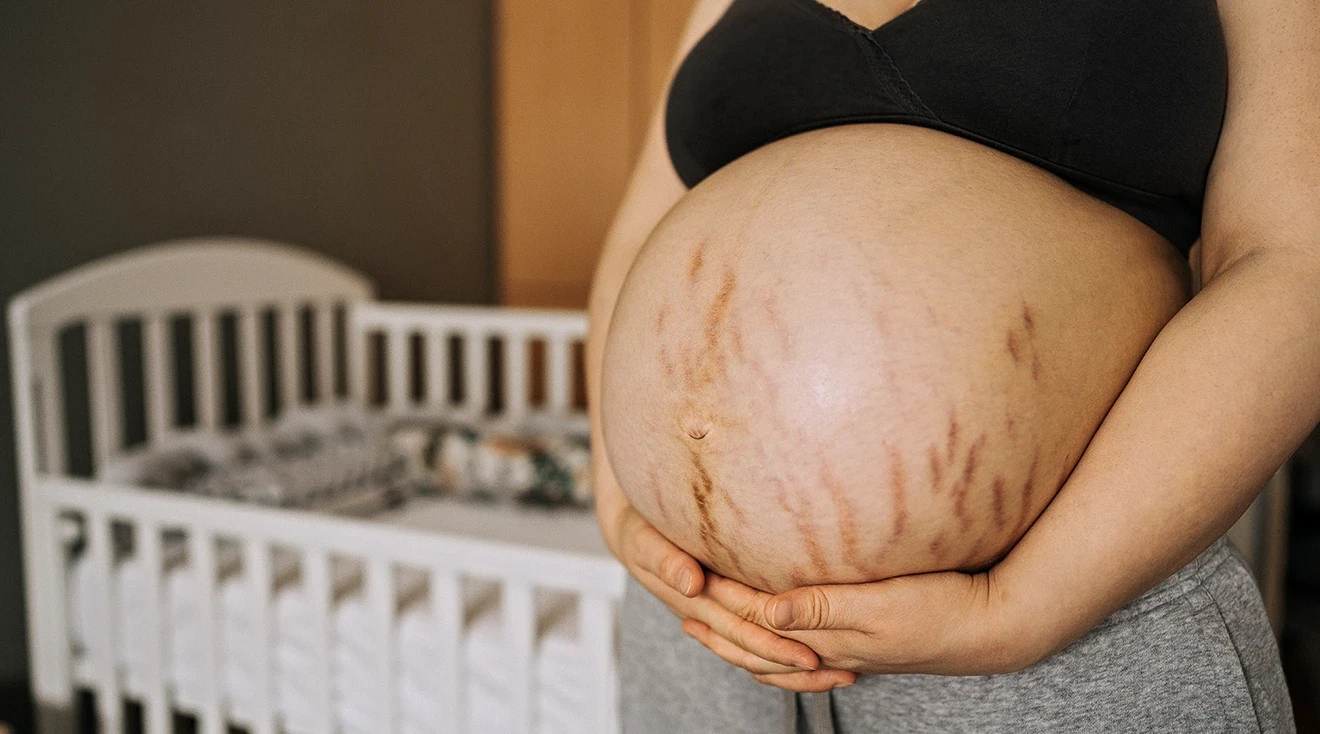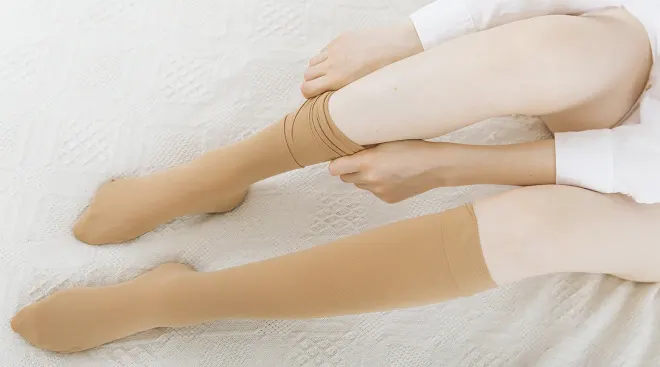
Can You Prevent Pregnancy Stretch Marks? Here’s the Deal
A baby bump is the marker of pregnancy, but alongside it comes another well-known bodily change: stretch marks. They’re incredibly common: Up to 90 percent of women experience stretch marks during pregnancy. Curious what causes them, where they might pop up and how to prevent stretch marks during pregnancy? We asked experts to explain why and when pregnancy stretch marks appear and whether it’s possible to avoid getting them.
According to the American Academy of Dermatology Association (AAD), stretch marks are scars that develop when the skin stretches or shrinks rapidly—and with your ever-growing baby bump, your skin is being stretched constantly throughout pregnancy. This quick change results in small ruptures to the collagen and elastin within the skin, and the scars that form as the skin heals are stretch marks.
That said, not everyone will get stretch marks during pregnancy. Your likelihood depends on a few factors:
-
Hormonal changes during pregnancy: According to the American Pregnancy Association (APA), the increased level of hormones during pregnancy relaxes the bonds between collagen fibers within the skin, making it easier for the skin to tear when stretched.
-
Genetics: Your risk of getting pregnancy stretch marks might be higher if others in your family get them, the AAD says. (So, if your mom, sister or aunt has stretch marks, odds are you will too.)
-
Pregnancy weight: Weight gain is necessary for baby’s development and well-being, but how much weight is gained and how quickly may contribute to the appearance of stretch marks, says Cynthia Flynn, MD, a Florida-based ob-gyn with JustAnswer.
-
Twins or multiples: If you’re carrying more than one baby, your bump may be larger and you might experience a little more pregnancy weight gain, causing your skin to stretch a little more than it would with a singleton pregnancy.
The one common theme among all four factors? Almost all of them are entirely out of your control. While it can be jarring to see your formerly bare bump speckled with pregnancy stretch marks, remember it’s a completely natural and beautiful part of the journey.
Pregnancy stretch marks are often red, pink, purple, reddish-brown or brown, depending on your skin tone, the AAD says. Early pregnancy stretch marks can be slightly raised and feel itchy as they heal, but over time the color will fade and they’ll become level with your skin (though you may feel a slight depression in the skin when running your finger over mature stretch marks). “They often start as a small spot that can be itchy, and they can grow into a line over time,” says Rebekah Mustaleski, CPM, a certified professional midwife and compression director at Motif Medical.
Keep in mind the itching from pregnancy stretch marks should be mild. If you experience extreme itchy stretch marks during pregnancy or notice a rash on your abdomen (or other parts of the body), flag it to your ob-gyn, Mustaleski says. Extreme itchiness could be a sign of another pregnancy skin condition called a PUPPP rash.
Stretch marks can appear anywhere the skin stretches rapidly, but pregnancy stretch marks usually occur on the abdomen, Mustaleski says, as it’s where the skin stretches most to make room for a growing baby. Other parts of the body you might find stretch marks from pregnancy include the hips, upper thighs, breasts and upper arms. “Stretch marks can show up all over the body,” Mustaleski explains. “They aren’t limited to one particular area.”
As for when stretch marks appear in pregnancy, according to Christine Greves, MD, an ob-gyn in Orlando, Florida, most pregnant people will start to notice stretch marks by the start of the third trimester. “Stretching of the skin occurs in the second trimester, so [there’s a] likelihood of having stretch marks by the third trimester,” she explains. Some people, however, may not see them until the middle of the third trimester, Mustaleski adds, while others may start seeing them as soon as their bump starts growing, the APA notes. Of course, some people may not have stretch marks during pregnancy at all, based on their genetics and their skin’s natural elasticity.
The question is frequently asked: Can you prevent stretch marks during pregnancy? Unfortunately, there are no surefire ways. Plus, it can be hard to treat them during pregnancy, as they’re always changing, Flynn explains. That said, there may be some ways to help early pregnancy stretch marks heal so as to minimize their appearance later on, Greves notes. Below, some ways to reduce stretch marks during pregnancy, if that’s your goal. Just remember that stretch marks are a completely natural part of pregnancy and are nothing to be ashamed of.
Drink a lot of water
Drinking water during pregnancy is important for several reasons. Not only does it help baby’s development, but it also helps keep your skin healthy, which in turn may help with the appearance of stretch marks. But it’s important to note that while some studies suggest drinking water may boost skin health, there’s no hard evidence that it prevents pregnancy stretch marks.
Watch your diet and nutrition
Along with drinking enough water, make sure to pay attention to your diet. “Your nutrition and hydration can help minimize stretch marks if they do start to show up, so keep eating nutrient dense foods, drink lots of water every day and take your prenatal supplements,” Mustaleski recommends. “You can’t make the stretch marks disappear, but giving your body the nutrients your skin needs to be healthy will be beneficial.” She suggests eating a whole food diet that includes plenty of vitamin C, vitamin D, zinc, collagen and vitamin E to “help your skin have the elasticity it needs to stretch during pregnancy.” A focus on your nutrition may also help with well-paced, beneficial weight gain throughout your pregnancy, which can also help minimize the risk and appearance of stretch marks.
If you’re going down the Google rabbit hole, you might read that avoiding caffeine may also help prevent pregnancy stretch marks—or that coffee body scrubs may minimize their appearance—but there’s no hard evidence to back up either claim.
Keep your skin moisturized
There are plenty of stretch mark creams on the market designed to minimize the appearance of pregnancy stretch marks. While there’s no guarantee that these lotions and creams will work, moisturizing is a great way to protect your skin’s elasticity, Mustaleski says. Flynn recommends liberally using Palmer’s Cocoa Butter, while the APA recommends using Bio-Oil twice daily throughout pregnancy. According to the AAD, creams with hyaluronic acid may also help, as it was found to boost skin collagen production in a recent 2016 and 2019 study.
Along with picking a pregnancy-safe product that hydrates your skin, the AAD also notes that early intervention may be important, as using moisturizers on early pregnancy stretch marks might have more of an effect than on mature stretch marks. Take the time to really massage the product into your skin and use it every day for weeks, the org notes, as results may take a while to appear. And resist the urge to scratch, Greves says. Instead, try finding some relief by applying moisturizer to the area.
Pregnancy stretch marks are essentially scars, which means they’re permanent. However, they will fade over time and become less noticeable. “Time is the best way to lessen the appearance of stretch marks,” Mustaleski says, as they naturally fade six to 12 months following birth—and may even fade for years afterward. “They’re always worst during and right after pregnancy,” Flynn says, “so it’s best to wait a year before really trying to intervene” if that’s your goal, as it often takes that long just to “get an idea of what they’ll look like moving forward.” If you’re unhappy with your stretch marks after baby’s arrival, Mustaleski and Flynn recommend seeing a dermatologist for cosmetic treatments, like prescription creams and laser therapy.
It can be challenging to come to terms with all the bodily changes pregnancy brings. But, like so many other things while expecting, stretch marks from pregnancy do get better with time. Until then, try seeing them for what they are: a beautiful reminder of the amazing work your body’s doing to grow and nourish your child. Your pregnancy stretch marks shouldn’t be something to hide—they’re something to celebrate.
Please note: The Bump and the materials and information it contains are not intended to, and do not constitute, medical or other health advice or diagnosis and should not be used as such. You should always consult with a qualified physician or health professional about your specific circumstances.
Plus, more from The Bump:
Cynthia Flynn, MD, is a board-certified ob-gyn based in Florida with over 20 years of experience. She is also an expert with the online platform JustAnswer. She received her degree from the Michigan State University College of Human Medicine.
Rebekah Mustaleski, CPM-TN, IBCLC, is a certified professional midwife specializing in evidence-based maternity care. She co-founded Roots & Wings Midwifery in Knoxville, Tennessee. Mustaleski received her bachelor’s degree in psychology from Centre College and worked as a doula and birth photographer prior to establishing Roots & Wings.
Christine Greves, MD, is an ob-gyn at the Winnie Palmer Hospital for Women & Babies in Orlando, Florida. She received her medical degree from the University of South Florida.
British Journal of Dermatology, Stretch marks during pregnancy: a review of topical prevention, March 2015
American Academy of Dermatology Association, American Academy of Dermatology Association, 2023
American Pregnancy Association, Pregnancy Stretch Marks, 2023
Clinical, Cosmetic and Investigational Dermatology, Dietary water affects human skin hydration and biomechanics, August 2015
Journal of the European Academy of Dermatology and Venereology, Topical management of striae distensae (stretch marks): prevention and therapy of striae rubrae and albae, February 2016
Indian Dermatology Online Journal, Striae Distensae Treatment Review and Update, August 2019
Learn how we ensure the accuracy of our content through our editorial and medical review process.
Navigate forward to interact with the calendar and select a date. Press the question mark key to get the keyboard shortcuts for changing dates.





















































